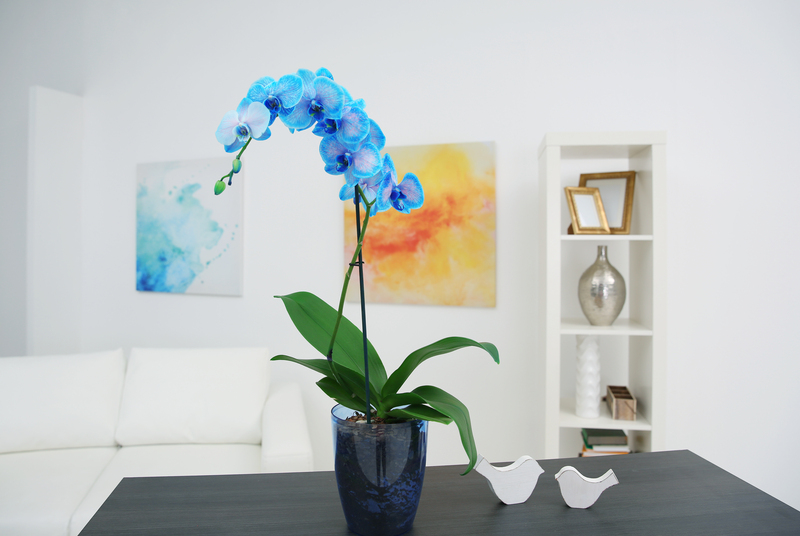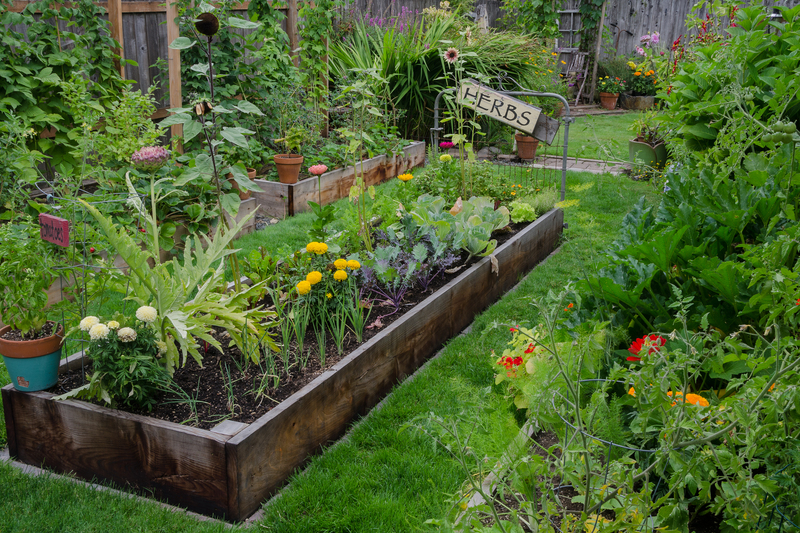The Art of Designing a Joyful Garden for Kids
Posted on 11/09/2025
The Art of Designing a Joyful Garden for Kids
Creating a kids' garden is about so much more than planting flowers and sticking in a swing set. It's about building a magical outdoor world where children's imagination, curiosity, and creativity blossom alongside the plants. Whether you have a sprawling backyard or a cozy patio, designing a joyful garden for kids offers endless opportunities for fun, discovery, and lasting memories. Let's take a step-by-step journey into the art of crafting a vibrant, playful, and safe garden space that will delight and engage children of all ages.
Why a Child-Friendly Garden Matters
In today's digital world, kids spend less and less time outdoors. A joyful kids' garden helps reconnect them with nature, offering benefits such as:
- Physical activity through running, climbing, digging, and exploring.
- Sensory stimulation from different textures, scents, and colors.
- Learning opportunities about plants, insects, seasons, and ecosystems.
- Space for creativity, pretend play, and social bonding.
- Emotional well-being fostered by fresh air, sunshine, and tranquil green spaces.
When you focus on designing a fun kids' garden, you nurture minds and bodies--creating a space kids love while fostering a lifelong appreciation for the natural world.

Planning Your Joyful Garden for Kids
An exciting children's garden doesn't have to be expensive or elaborate. Thoughtful planning helps you design a safe, stimulating, and engaging space. Start with these questions:
- How old are the children? (Toddler, preschool, grade-school?)
- How much space do you have? (Yard, balcony, containers?)
- What are the sun, shade, and soil conditions?
- What playful features would your kids love? (Sandpits, hiding spots, water games?)
- How will you ensure safety? (Non-toxic plants, safe surfaces, easy supervision?)
Involving children in the design process builds excitement and ensures the garden reflects their unique personalities. Encourage them to share favorite colors, flowers, or play ideas. When they help make decisions, they'll take pride in their joyful garden!
Key Elements for Designing a Kids' Garden
For the most joyful garden design for kids, mix elements that appeal to all the senses and encourage a variety of activities:
- Play structures: Swings, slides, climbing frames, and tepees.
- Edible gardens: Easy-to-grow veggies, fruits, or herbs.
- Sensory features: Plants with interesting textures, fragrant flowers, wind chimes, and water features.
- Secret spaces: Willow tunnels, sunflower houses, or shady nooks for quiet time.
- Wildlife habitats: Bug hotels, bird feeders, butterfly-attracting plants.
- Creative corners: Outdoor chalkboards, mud kitchens, or fairy gardens.
Remember to combine open spaces for running with cozy corners for reading or daydreaming. A well-balanced design keeps children engaged and happy, whatever their mood.
Choosing Kid-Friendly Plants
Selecting plants for a children's garden is both science and art. You want varieties that are safe, sturdy, and delight the senses. Here are some guidelines for planting a joyful and child-friendly garden:
Safety First!
- Avoid toxic plants--consult local authorities or garden centers for non-toxic lists specific to your area.
- Watch for prickles: Steer clear of plants with sharp thorns or spines, such as roses or barberries.
- Mind allergies: If your child has pollen, bee, or food allergies, check plant suitability.
Fun and Hardy Choices
- Sunflowers: Tall, cheerful, fast-growing, and great for sunflower houses.
- Strawberries: Low, tasty, and perfect for little hands to pick.
- Marigolds: Bright orange flowers that repel pests and bloom all summer.
- Snapdragons: Whimsical blooms that "snap" open and close.
- Mint and basil: Fragrant, quick-growing, and fun to use in drinks or snacks.
- Pumpkins: Big leaves, sprawling vines, and magical autumn harvests.
- Lamb's ear: Soft, fuzzy leaves for sensory exploration.
- Nasturtiums: Edible flowers and leaves, easy to grow, and attract pollinators.
Tip: Mix in bulbs like crocuses or daffodils for delightful spring surprises. Choose a blend of annuals and perennials for year-round interest with minimal maintenance.
Creative Play Zones in a Kids' Garden
Purposefully designed play zones ensure that your joyful garden for children accommodates every play style, mood, and season. Feel free to mix and match these ideas based on your child's age and interests.
1. The Edible Garden Patch
- Raised beds or containers are perfect for vegetables, fruits, and herbs.
- Let kids plant, weed, water, and harvest--the thrill of tasting something they've grown is magical!
- Include labels, fun signs, or painted rocks to add colorful education.
2. Water Play and Mud Kitchens
- Install a sturdy mud kitchen with old pots and pans for hours of imaginative "cooking."
- Add a water table, shallow basin, or solar-powered fountain for splashing and science learning.
- Mark off a dedicated muddy digging area; kids love sensory messes when they're safe and contained.
3. Secret Hideouts and Quiet Spaces
- Grow living willow tunnels or teepees for shady, natural forts.
- Cluster large sunflowers or tall grasses to make secret hideaways.
- Place a cozy bench, hammock, or beanbag for reading or cloud-watching.
4. Art and Construction Corners
- Encourage creativity with an outdoor chalkboard, pebble mosaics, or a sand art station.
- Provide buckets, sticks, and safe hand tools for building and experimenting.
5. Wildlife Wonders
- Install a bug hotel or butterfly feeder and watch pollinators and insects arrive.
- Hang a simple bird feeder or bird bath--kids can track visiting species and record sightings.
Safety Considerations for Kids' Gardens
Safety is paramount when designing a playful garden for young ones. Consider these essentials:
- Soft landings: Use grass, mulch, or rubber mats below climbing structures or swings.
- Clear boundaries: Fence the area to prevent children from straying unsupervised.
- Pond precautions: Any water features should be shallow, covered, or securely fenced.
- Chemical-free care: Avoid pesticides and herbicides. Opt for organic gardening tricks instead.
- Easy visibility: Design so you can supervise all spaces from the house or patio.
- Routine checks: Regularly inspect play equipment and prune overgrown branches.
Keeping the garden tidy minimizes hazards, while child-sized tools and gloves encourage participation and safety.
Seasonal Joy: Making Your Kids' Garden Fun All Year
Design your children's joyful outdoor space for year-round adventure by planning for every season:
- Spring: Sow seeds, watch bulbs bloom, go on bug hunts, and build fairy houses.
- Summer: Harvest strawberries, set up water play, picnic on the lawn, or create nature art.
- Autumn: Collect leaves, grow pumpkins, dig up root veggies, or host a mini harvest festival.
- Winter: Make bird feeders from pinecones, create ice ornaments, or use twigs and old seed packets for craft projects.
Let your garden evolve as your children grow, adding new features or plants each year to keep it fresh and exciting.
Inspiring Ideas from Around the World
Kid-friendly gardens come in all shapes, sizes, and styles. Seek inspiration from:
- Public children's gardens: Local botanical gardens often feature interactive zones and natural play areas.
- Montessori and Waldorf principles: Emphasize natural materials, child-led learning, and sensory experiences.
- International traditions: Explore concepts like Japanese sukiya-style play gardens or Swiss adventure playgrounds.
Visit other gardens, browse books and online galleries, or talk to neighbors for fresh ideas on joyful children's garden design.
Easy DIY Projects for a Joyful Children's Garden
Simple projects can add magic to your outdoor play garden:
- Stepping stones: Create mosaic or hand-print tracks winding through the garden.
- Tire planters: Paint bright old tires and stack for bold, movable flower beds.
- Wind chimes: Use shells, bamboo, and metal scraps for musical breezes.
- Bug hotels: Bundle bamboo, sticks, pinecones, and bricks for pollinator shelters.
- Sunflower houses: Plant a circle of tall sunflowers with a gap for a secret entrance.
Let children help with painting, planting, and constructing--creativity is what makes the garden truly joyful.

Maintenance Tips: Nurturing Kids' Gardens Together
Involving children in garden care teaches responsibility and respect for the environment. Make maintenance fun with these tips:
- Assign simple, age-appropriate chores: Watering, weeding, harvesting, or filling birdbaths.
- Create a shared garden journal: Track plant growth, animal sightings, and favorite activities.
- Celebrate milestones: Host "garden parties" to mark a new crop or blooms.
- Swap jobs weekly to keep things fresh and fair for siblings or friends.
Conclusion: The Joy of Growing Together
Designing a joyful garden for kids is not only about colors, scents, and play--it's about nurturing young minds and hearts. A well-thought-out play garden helps children fall in love with the great outdoors, fosters important life skills, and provides space to laugh, learn, and relax. With a little creativity, care, and collaboration, your family can transform any outside area into a magical landscape where joy flourishes season after season.
So, pick up your spade, gather your little gardeners, and start designing a kids' garden adventure that will bloom for years to come!

